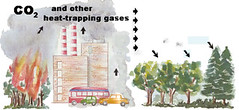Marketing commercial districts with beauty through trees

From the Northwest Environment Watch's BLOG (thanks to Katie Salay of PPS for sussing out this info)--
Marketing with Trees
Urban ecologists are fond of reciting the benefits of trees in the big city: they reduce storm water runoff, absorb pollutants, increase real estate values, and make neighborhoods more attractive. But a recent study shows that urban trees may have an unexpected bonus for city shopkeepers: apparently shoppers are willing to pay extra to shop near trees.
UW professor Kathleen Wolf showed photos of retail streets with and without trees to inner-city residents across the US and asked how much they would be willing to pay for a variety of items at each location. The study participants perceived shops on treed streets not only as better maintained and having a more pleasant atmosphere but also as likely having higher quality products.
These perceptions may translate into more business, because participants also said they were willing to drive farther to those shops (expanding the customer pool) and to pay more for parking. And most important for the bottom line, trees may lead to higher prices: on average, participants said they were willing to pay nearly 12% more to shop on treed streets than on treeless ones.
Also, see the follow-up blog entry, "Marketing with Trees II" with this additional interesting info--
A brief follow-up to Jessica’s urban forests post: urban forests have additional benefits to businesses; however this information is, sadly, not widely known. Other research--in addition to the study by Kathy Wolf that Jessica cited--has found customers were willing to travel farther (hopefully on transit) to reach well-vegetated businesses [1], and the quality of landscaping along approach routes to business districts has also been found to positively influence consumer perceptions [2].
And a study using a detailed pricing model on existing commercial building rents found a clear relationship between quality landscaping and higher office rental rates; quality landscaping (neat, well-groomed, attractive, able to see the business) increased rental rates by 7 percent, as did good building shade [3].
Businesses also experience increased productivity when their employees are exposed to green spaces: Desk workers who can see nature from their desks take 23 percent less time off sick than those who don’t see any green from their windows, and they also report greater job satisfaction [4].
The references are listed in the original entry.
___________
This is important because store owners often are against trees figuring that trees block views into windows from the street.
Additional resources include the Urban Horticulture Institute of Cornell and the Urban Forestry Program of the State of Georgia.



0 Comments:
Post a Comment
<< Home